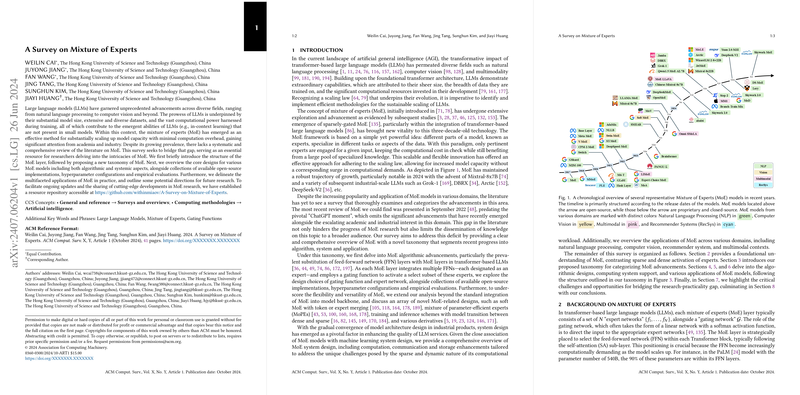An Analytical Overview of "A Survey on Mixture of Experts"
The academic paper titled "A Survey on Mixture of Experts" presents a comprehensive examination of the Mixture of Experts (MoE) strategy, a powerful paradigm leveraged to expand model capacity without proportionally increasing computational costs. This survey endeavors to consolidate the extensive literature on MoE and to present a novel taxonomy that encapsulates the multi-faceted dimensions of MoE research, encompassing algorithmic and systemic enhancements as well as diverse practical applications.
The paper is structured around a detailed taxonomy that offers a profound insight into the MoE landscape. This classification delineates the MoE paradigm through three primary lenses: algorithm design, system design, and applications. Let us delve into each of these components, understanding their implications for MoE’s development and deployment.
Algorithm Design of MoE
The heart of MoE models lies in their algorithm design, featuring a robust framework that involves the dynamic selection of expert networks via gating mechanisms. This paper categorizes gating functions into three distinct types: sparse, dense, and soft. Sparse gating functions, inspired by classical MoE strategies, activate a subset of experts and have been advanced through heuristic and reinforcement-based methods to enhance load balancing and routing efficiency. Dense gating functions, although more computationally intensive, ensure stable expert activation, making them suitable for certain parameter-efficient fine-tuning tasks. The innovative soft gating functions, which involve token or expert merging, offer a fully-differentiable approach to MoE training, mitigating some computational inefficiencies inherent in sparse gating.
The paper thoroughly explores expert network types, moving beyond the prevalent use of feed-forward networks (FFN) to include diverse architectures like convolutional and attention-based networks. The investigation into the hyperparameters critical to MoE’s performance provides a meticulous guide for setting these parameters to optimize model efficiency across applications. Moreover, the research discusses the promising fusion of MoE with parameter-efficient fine-tuning techniques, creating a hybrid approach that merges the benefits of MoE's dynamic structure with the resource efficacy of fine-tuning.
System Design of MoE
The system design challenges are pivotal in scaling MoE models effectively. The paper highlights expert parallelism as the foundational strategy to manage MoE’s computational workload. This is complemented by insights into hybrid parallelism schemes that synchronize the computational tasks across distributed systems, addressing bottlenecks such as communication overhead and load imbalances. Innovative solutions, such as dynamic expert placement and pipelining, are discussed to improve both computational throughput and efficiency in diverse hardware setups. The integration of tailored GPU kernels and advanced load management strategies exemplifies the pragmatic system enhancements necessary to harness the theoretical efficiency promised by MoE architectures.
Applications in Various Domains
The practical applications of MoE span a multitude of fields, demonstrating its versatility. In natural language processing, MoE models have substantially improved performance in standard tasks like translation, question answering, and code generation. In the field of computer vision, MoE innovations like Vision MoE (V-MoE) showcase the model's potential to process complex visual patterns efficiently. MoE has also shown its value in the demanding environment of recommender systems, adeptly balancing the demands of multi-task learning. Additionally, in multimodal contexts, MoE's ability to process and integrate diverse data types, such as text and images, has facilitated the creation of sophisticated, efficient models that tackle the high-dimensional, complex structure of multimodal data.
Challenges and Future Directions
Despite the advances enabled by MoE, the paper identifies several ongoing challenges that necessitate further research. Ensuring training stability, particularly with sparse gating, and addressing load balancing inefficiencies remain critical. The inherent complexity of MoE necessitates interpretability frameworks to elucidate its decision-making processes, enhancing transparency. Moreover, advancing system integrations to accommodate MoE's unique architecture and optimizing expert networks' specialization continue to be areas ripe for exploration. Future research could greatly benefit from developing more robust algorithms for gating, exploring new network architectures for experts, and refining parallelism strategies to reduce the computational and communication overhead further.
Conclusion
This survey on MoE represents an exhaustive and pivotal contribution to the understanding and advancement of scalable machine learning models. The insightful review offered in this paper provides a foundation for further innovation in MoE models, aiming to overcome existing challenges and exploit future opportunities. Providing a balanced account of both theoretical underpinnings and practical implementations, this survey serves as a vital resource for researchers and practitioners striving to optimize AI systems' effectiveness and efficiency. The future of MoE holds great promise, contingent on the insightful distillation of ongoing research and transformative applications across multiple domains. This paper lays the groundwork for such transformative endeavors.
